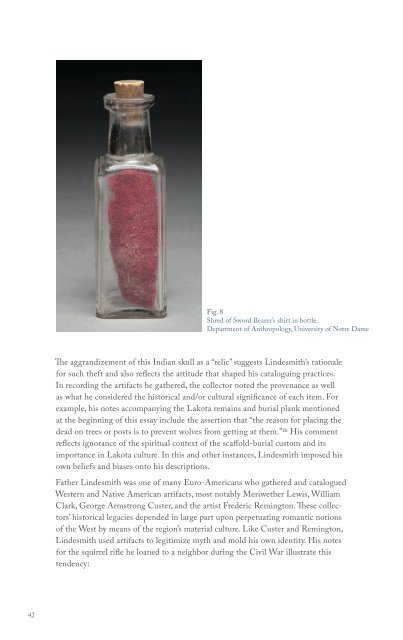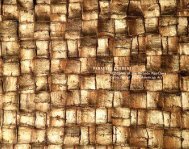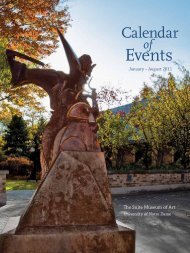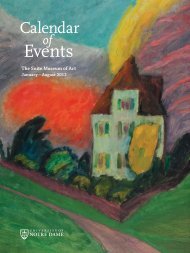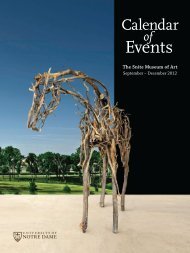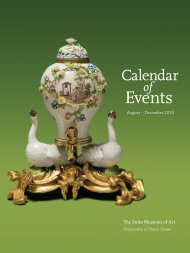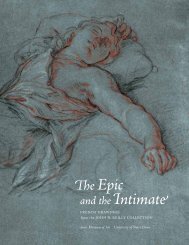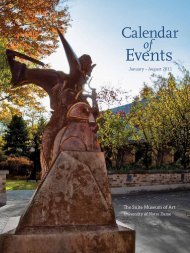HISTORY INTO ART AND ANTHROPOLOGY - Snite Museum of Art ...
HISTORY INTO ART AND ANTHROPOLOGY - Snite Museum of Art ...
HISTORY INTO ART AND ANTHROPOLOGY - Snite Museum of Art ...
Create successful ePaper yourself
Turn your PDF publications into a flip-book with our unique Google optimized e-Paper software.
Fig. 8<br />
Shred <strong>of</strong> Sword Bearer’s shirt in bottle.<br />
Department <strong>of</strong> Anthropology, University <strong>of</strong> Notre Dame<br />
The aggrandizement <strong>of</strong> this Indian skull as a “relic” suggests Lindesmith’s rationale<br />
for such theft and also reflects the attitude that shaped his cataloguing practices.<br />
In recording the artifacts he gathered, the collector noted the provenance as well<br />
as what he considered the historical and/or cultural significance <strong>of</strong> each item. For<br />
example, his notes accompanying the Lakota remains and burial plank mentioned<br />
at the beginning <strong>of</strong> this essay include the assertion that “the reason for placing the<br />
dead on trees or posts is to prevent wolves from getting at them.” 25 His comment<br />
reflects ignorance <strong>of</strong> the spiritual context <strong>of</strong> the scaffold-burial custom and its<br />
importance in Lakota culture. In this and other instances, Lindesmith imposed his<br />
own beliefs and biases onto his descriptions.<br />
Father Lindesmith was one <strong>of</strong> many Euro-Americans who gathered and catalogued<br />
Western and Native American artifacts, most notably Meriwether Lewis, William<br />
Clark, George Armstrong Custer, and the artist Frederic Remington. These collectors’<br />
historical legacies depended in large part upon perpetuating romantic notions<br />
<strong>of</strong> the West by means <strong>of</strong> the region’s material culture. Like Custer and Remington,<br />
Lindesmith used artifacts to legitimize myth and mold his own identity. His notes<br />
for the squirrel rifle he loaned to a neighbor during the Civil War illustrate this<br />
tendency:<br />
When during the Civil War, David Todd, governor <strong>of</strong> Ohio, called on the<br />
Squirrel hunters <strong>of</strong> the state to hasten at once to the line <strong>of</strong> danger, against<br />
the approaching Confederate Army. Andrew Sothammer came running,<br />
late at night, almost out <strong>of</strong> breath to get my rifle. Of course I let him<br />
have it, and all the bullets, lead and powder I had, along with the bullet<br />
mold. We spend [sic] a good part <strong>of</strong> the night in molding bullets; and on<br />
the following morning, he and other squirrel hunters took the first train<br />
for the front in defense <strong>of</strong> the Union, the State <strong>of</strong> Ohio, and the City <strong>of</strong><br />
Cincinnati. This is the rifle. 26<br />
Although the U.S. Army had denied Lindesmith the opportunity to serve in the<br />
war, the loaned squirrel rifle, which saw use during the conflict, provided evidence<br />
to help authenticate his loyalty to the Union cause. This example is one <strong>of</strong> many<br />
demonstrating how Lindesmith redefined himself through his collection.<br />
Going west <strong>of</strong>fered Lindesmith an opportunity to feel, act, and serve as an American.<br />
And as a priest, marginalized by rampant sentiment that sought to cast Catholics as<br />
un-American, he regarded his Western adventure as pro<strong>of</strong> positive <strong>of</strong> his identity<br />
as a stalwart citizen. 27 Lindesmith sought to defend Catholicism against the roiling<br />
anti-Catholic movement by conflating his religion with material culture. He firmly<br />
believed that the acquisition and display <strong>of</strong> objects resonated with a meaning<br />
relevant to marginalized Catholics, who would embrace evidence that proved they<br />
were American and that might hinder discrimination and violence (fig. 9).<br />
Lindesmith’s characterization <strong>of</strong> the significance <strong>of</strong> a Catholic altar stone he<br />
obtained in September 1882 <strong>of</strong>fers another example <strong>of</strong> how he sought to find and<br />
express an American national identity through artifacts:<br />
The broken altar stone was used by Rev. John S. Venneman S. J. on the<br />
Montana missions during 3 years. He had dispensation to use it. He<br />
traveled at least 24 days each month. He gave me the stone. . . . This stone<br />
was carried many thousands <strong>of</strong> miles, among whites, Indians, soldiers,<br />
trappers, miners, explorers, and frontiers men <strong>of</strong> every kind on car[t}s,<br />
boats, stages and even muleback and <strong>of</strong>ten afoot through almost impenetrable,<br />
mountains, bluffs, cooleys [sic], rocks, canyons, forests, Badlands,<br />
prairies and over rivers without bridges— at all [hours] <strong>of</strong> the [day] and<br />
night—not knowing at what minute they might fall into the hands <strong>of</strong><br />
road-agents or hostile Indians by mistake. 28<br />
For Lindesmith, this traveling altar stone symbolized the rugged, masculine Wild<br />
West and the dangers associated with its unsavory characters and unforgiving<br />
terrain. Possessing it gave him something tangible to help prove that he, like the<br />
stone, had survived the West. Although the object was only about ten inches tall, it<br />
was also, in his words, a “moveable Catholic Church” 29 ; as such, Lindesmith relied<br />
on the story surrounding it as evidence that the Catholic Church deserved recognition<br />
and respect in America’s Western narrative.<br />
42 43


